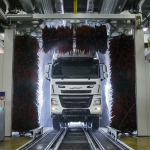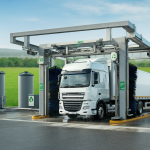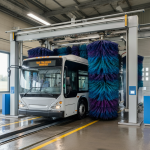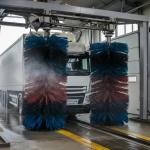Picture this: a fleet of gleaming trucks rolling out, each one pristine and ready to hit the road. The secret behind their shine? An expertly designed truck wash bay that caters to every need of commercial vehicles. But what does it take to create the ideal space for washing these heavy-duty machines? From ensuring proper drainage systems to incorporating advanced technology, every detail matters in crafting a successful truck wash operation.
In an industry where efficiency is key, understanding truck wash bay dimensions and features can set your facility apart. Whether you’re looking at drive-through designs or optimal equipment setups, there are specifications that will not only meet but exceed customer expectations. Join us as we explore everything you need for designing the ultimate truck wash bay—from essential structural features to innovative machinery—that guarantees satisfaction for both your clients and their vehicles!
Space Requirements: Minimum clearance for large commercial trucks (including trailers) Drive-through design or separate entry and exit points for efficient flow
When designing a truck wash bay, space requirements are crucial. Large commercial trucks and trailers demand specific minimum clearances to maneuver safely. Generally, you’ll need at least 14 feet of overhead clearance for most vehicles. This ensures that even the tallest rigs can enter and exit without a hitch.
A drive-through design is highly recommended for optimal traffic flow. It allows trucks to enter from one end and exit from another, minimizing congestion. This setup not only enhances efficiency but also reduces wait times for clients.
If space constraints prevent a drive-through option, consider separate entry and exit points. Marking these clearly will help guide drivers smoothly through the process while maintaining safety standards within your facility. Properly planned layouts lead to better customer experiences—an essential aspect when competing in today’s market!
Drainage System: Sloped flooring for proper runoff Grease traps and sediment catchment to prevent environmental contamination
A well-designed drainage system is vital for any truck wash bay. Sloped flooring plays a crucial role in ensuring proper runoff, directing water away from the washing area efficiently. This slope allows contaminants to flow seamlessly into designated drainage channels.
Incorporating grease traps is essential to capture fats and oils that can harm the environment. These traps prevent toxic substances from entering local waterways, supporting eco-friendly operations.
Sediment catchment systems enhance this effort by trapping dirt and debris before they reach larger drains or treatment facilities. This not only protects the ecosystem but also reduces maintenance costs associated with clogged pipes and filters.
Effective drainage design minimizes water pooling, reducing slip hazards for workers during busy hours. By investing in a robust drainage strategy, your truck wash bay will operate smoothly while upholding environmental responsibilities.
Water Reclamation System: Recycling and filtering system to reduce water usage
Implementing a water reclamation system in your truck wash bay can significantly lower overall water consumption. This sustainable approach captures, filters, and recycles the water used during wash cycles.
The initial step involves collecting runoff from the wash area. A well-designed drainage system directs this wastewater to a filtration unit. Here, contaminants like dirt and grease are removed before recycling the water back into your washing equipment.
This not only conserves precious resources but also minimizes environmental impact. By reducing reliance on municipal water supplies, businesses can save money over time.
Additionally, utilizing recycled water doesn’t compromise cleaning quality. With proper treatment and filtration systems in place, you can achieve results that satisfy even the most discerning customers while promoting eco-friendly practices within your operation.
Zoning and Compliance: Ensure local building codes and environmental regulations are met Separation of washing area from office or parking zones
When designing a truck wash bay, zoning and compliance are paramount. Understanding local building codes is essential to avoid costly renovations later on. Each municipality may have specific regulations regarding the construction of such facilities, especially concerning safety and environmental sustainability.
Separating the washing area from office or parking zones not only enhances efficiency but also minimizes contamination risks. This strategic layout prevents runoff and chemical exposure in areas where employees operate or trucks park.
Proper zoning ensures that noise levels from equipment do not disrupt nearby businesses or residences. It’s vital for maintaining good relationships with the surrounding community while complying with regulations designed to protect public health.
Investing time in thorough planning can pay off significantly by ensuring smooth operational flow and adherence to necessary standards throughout your truck wash facility’s lifecycle.
Structural Features Durable Flooring: Chemical-resistant concrete or epoxy-coated flooring
Choosing the right flooring for a truck wash bay is crucial. Durable options like chemical-resistant concrete or epoxy-coated surfaces stand out for their resilience.
These materials can withstand harsh cleaning agents and heavy traffic. This means less wear and tear over time, translating to lower maintenance costs in the long run.
Epoxy coatings are particularly beneficial as they create a smooth surface that facilitates easy cleaning. They also minimize stains from oil, grease, and other contaminants common in automotive care.
Chemical resistance protects your investment by preventing degradation from spills or leaks. Plus, textured finishes can enhance safety by providing grip even when wet—essential in high-traffic areas where slippery conditions might occur.
Investing in durable flooring ensures your truck wash bay remains functional and efficient while maintaining an attractive appearance that pleases both staff and clients alike.
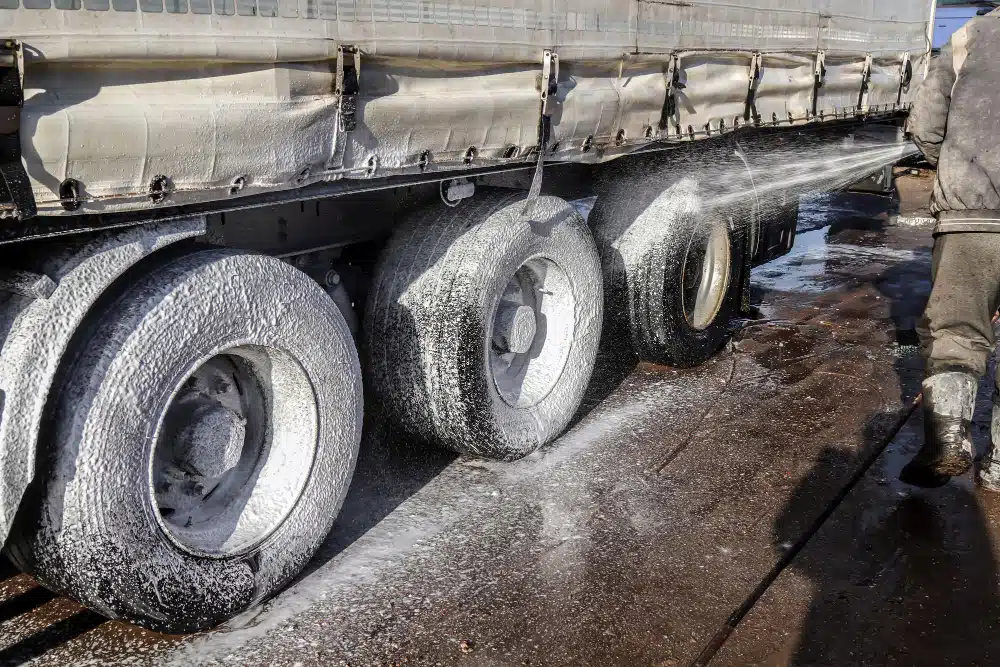
Overhead Clearance: Sufficient height for high-clearance trucks and trailers
When designing a truck wash bay, ensuring adequate overhead clearance is crucial. High-clearance trucks and trailers come in various sizes. A well-planned space accommodates these larger vehicles without any risk.
Many commercial trucks can reach heights of 13 to 14 feet or more, especially when loaded. The wash bay should allow for this extra height along with any additional equipment like foamers or drying systems mounted on the ceiling.
This aspect not only prevents damage but also enhances efficiency during the washing process. Workers can maneuver freely, avoiding unnecessary delays caused by tight spaces.
Incorporating sufficient overhead clearance contributes to overall safety as well. With ample room, operators are less likely to encounter accidents while managing vehicle washes. This attention to detail fosters a smoother workflow and improves customer satisfaction.
Pressure-resistant Walls: Materials that withstand high-pressure cleaning and water exposure
When designing a truck wash bay, pressure-resistant walls are crucial. They must endure high-pressure cleaning without deteriorating.
Materials like reinforced concrete or fiberglass composites excel in this role. Their durability ensures they can take the constant barrage of water and chemicals.
Specialized coatings can further enhance these surfaces, providing an added layer of protection. Epoxy finishes resist chipping and cracking while offering easy cleaning options.
Choosing the right materials also minimizes maintenance costs over time. They withstand harsh environments, ensuring longevity against wear and tear from frequent washing operations.
Incorporating these robust materials not only safeguards your investment but also contributes to operational efficiency in the long run. Quality walls lead to fewer repairs and disruptions, allowing for uninterrupted service flow within your wash bay area.
Climate Control: Heated floors or walls for cold climates (prevents freezing) Proper ventilation to reduce humidity buildup
Maintaining the right climate within a truck wash bay is crucial, especially in colder regions. Heated floors or walls can significantly enhance efficiency during winter months. This feature prevents freezing of water and equipment, ensuring that washing operations remain smooth.
Proper ventilation plays an equally important role. It helps reduce humidity buildup, which can lead to mold growth and damage to both vehicles and infrastructure. A well-ventilated space enhances air quality for workers as well.
Additionally, effective airflow systems help dry trucks faster after washing. This reduces downtime and improves customer satisfaction by speeding up service times.
Investing in climate control not only protects your equipment but also creates a more comfortable working environment for staff members. It’s a win-win situation that contributes to the overall functionality of your truck wash facility.
Equipment and Machinery High-Pressure Washers: Multiple pressure washers with adjustable PSI for different cleaning needs Hot water capability for tougher grime
High-pressure washers are the backbone of any efficient truck wash bay. They’re designed to tackle everything from light dirt to heavy grime, making them essential for maintaining a clean fleet.
Having multiple pressure washers with adjustable PSI settings allows operators to customize their cleaning approach based on specific needs. Lower PSI is perfect for delicate surfaces, while higher PSI can blast away stubborn mud and road salt.
The capability of hot water adds another layer of effectiveness. Hot water breaks down grease much more efficiently than cold water, ensuring that every nook and cranny gets the attention it deserves. This feature is particularly useful in colder climates where grime tends to freeze onto surfaces.
Combining these elements creates a powerful setup that not only enhances cleanliness but also boosts customer satisfaction by delivering consistently impressive results.
Automatic Wash Systems (Optional): Automated brushes, arms, and sprayers for consistent and fast cleaning
Automatic wash systems can revolutionize the efficiency of truck cleaning. These setups use advanced technology to ensure every vehicle receives a thorough wash.
Automated brushes glide along the surface, removing dirt and grime without manual effort. This not only speeds up the washing process but also guarantees consistency across different trucks.
Integrating sprayers enhances this experience by applying soaps and detergents uniformly. With adjustable pressure settings, they cater to various cleaning needs, ensuring that even stubborn stains are addressed effectively.
Moreover, automatic washers reduce labor costs significantly while maintaining quality control. Time spent on each vehicle decreases dramatically, allowing for more trucks to pass through in less time.
Touchless options are available too, utilizing high-pressure water jets that clean efficiently without direct contact with the vehicle’s surface—ideal for delicate finishes or specialized fleets. The result is a cleaner truck in less time, boosting customer satisfaction profoundly.
Touchless washing
Touchless washing has revolutionized the way trucks are cleaned. This innovative approach minimizes contact with surfaces, reducing the risk of scratches while delivering a thorough wash.
Utilizing high-pressure water jets and specialized cleaning solutions, touchless systems effectively remove dirt and grime without brushes or scrubbing mechanisms. The technology relies on intelligent spray patterns that reach every inch of the vehicle’s surface.
One significant advantage is efficiency. These systems can wash an entire fleet quickly, enhancing productivity for businesses where time is money.
Moreover, touchless washing often incorporates environmentally friendly detergents, ensuring that tough stains don’t harm Mother Nature.
With less physical wear on vehicles and rapid turnaround times, this method appeals to truck owners seeking quality care with minimal fuss.
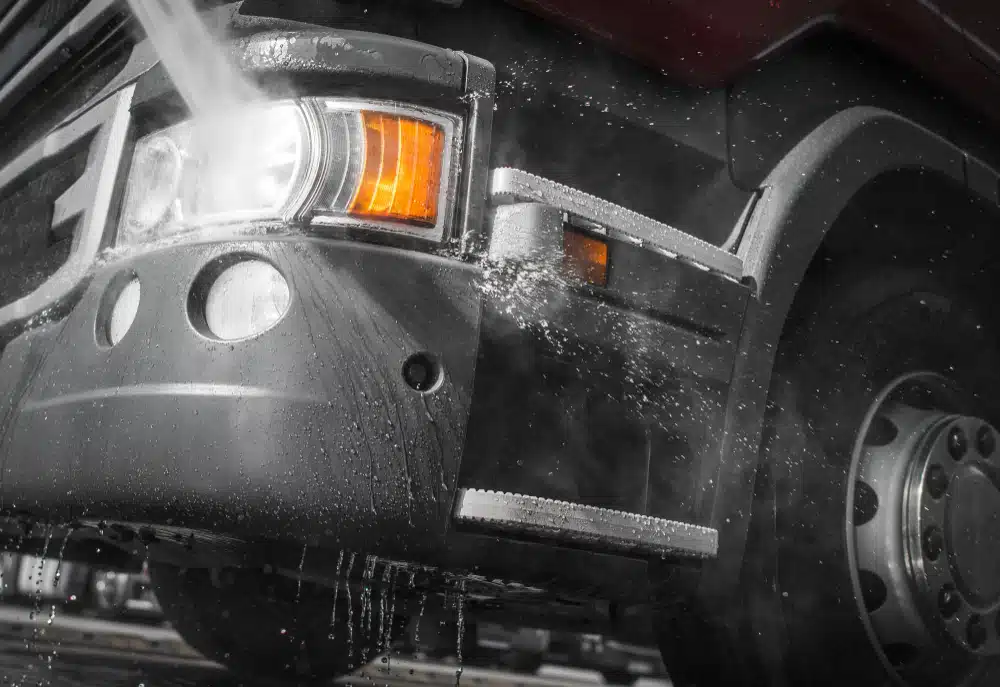
Friction (Brush) washing
Friction washing utilizes rotating brushes to scrub surfaces, providing a thorough clean that high-pressure sprays alone may not achieve. These brushes are designed to be gentle yet effective, ensuring that even the most stubborn grime and dirt are removed without damaging the vehicle’s finish.
The technology behind friction washers allows for adjustable brush pressure. This adaptability means they can cater to various truck sizes and materials, offering flexibility in cleaning options.
In addition to effectiveness, friction washing often enhances water efficiency by using less water compared to traditional methods. The combination of mechanical scrubbing with soap or detergents ensures an optimal clean while minimizing environmental impact.
Many operators appreciate how these systems reduce labor costs; one machine can handle multiple vehicles efficiently. With advancements in automation and sensors, modern friction washing systems can operate seamlessly within a truck wash bay setup.
Foamers and Pre-Wash Systems: Chemical foamers for applying soap or degreasing agents Pre-wash sprayers for loosening dirt
Chemical foamers play a vital role in the truck wash bay. They deliver thick layers of soap that cling to surfaces. This action allows detergents to penetrate grime, making subsequent cleaning more effective.
Using foam not only enhances cleaning efficacy but also reduces water consumption by targeting areas needing attention first. The visual appeal of frothy bubbles can even attract customers, showcasing your commitment to quality.
Pre-wash sprayers complement this process perfectly. These systems spray high-pressure jets designed to dislodge dirt before the main wash begins. By loosening stubborn soil and debris, they prepare surfaces for deeper cleansing.
Together, foam and pre-wash systems create a powerful duo in maintaining cleanliness while ensuring efficient operations. They enhance overall service speed without sacrificing quality, ultimately improving customer satisfaction in every visit.
Drying Systems: Industrial air blowers or heated drying systems
Effective drying systems are crucial for any truck wash bay. Industrial air blowers can quickly remove water from surfaces, preventing streaks and promoting a thorough finish. Their powerful airflow ensures that even the most intricate areas dry efficiently.
Heated drying systems are another excellent option. They utilize warmth to evaporate moisture, making them ideal for colder climates where freezing is a concern. By combining heat with airflow, these systems enhance the drying process significantly.
Both types of dryers should be strategically placed within the wash bay to optimize coverage. Proper positioning minimizes the time trucks spend waiting to leave after washing, improving overall efficiency and customer satisfaction. Investing in high-quality drying technology translates to cleaner vehicles and happier clients every time they visit your facility.
Chemical Systems Detergents and Degreasers: Industrial-grade cleaners for trucks, suited for removing road grime, grease, and salt Environmentally-friendly and biodegradable options
Selecting the right chemical systems for a truck wash bay is crucial. Industrial-grade detergents and degreasers effectively tackle stubborn road grime, grease, and salt accumulation. These powerful cleaners ensure that trucks leave the wash bay looking pristine.
Yet, with environmental concerns rising, many operators are turning to eco-friendly options. Biodegradable detergents offer a solution that cleans thoroughly without harming local ecosystems. They break down naturally and minimize pollution risks associated with traditional chemicals.
Utilizing these environmentally-conscious products does not compromise cleaning effectiveness. Advanced formulations provide robust cleaning power while being gentle on surfaces and safe for employees handling them.
Incorporating automated dosing systems can further enhance efficiency in applying these cleaners. This technology ensures precise measurements every time, reducing waste and promoting consistent results across all washes.
Dispenser System: Automated chemical dosing system for consistent and efficient applicant
A dispenser system revolutionizes the way chemicals are applied in a truck wash bay. With automation at its core, this technology ensures that every vehicle receives an accurate dose of detergents and degreasers.
This precision not only enhances cleaning efficiency but also minimizes waste. No more guesswork or manual mixing—everything is streamlined for optimal results.
Moreover, automated systems can be programmed to adapt based on specific requirements. For example, heavy-duty grime may require a stronger solution compared to routine washes.
Additionally, these dispensers often feature built-in monitoring capabilities. This allows operators to track usage patterns and make informed decisions about inventory management.
The ease of use translates into less labor-intensive processes as well. Workers spend less time measuring and pouring chemicals, allowing them to focus on other essential tasks within the wash bay environment.

Water Softening: Hard water treatment systems to prevent residue or scaling on trucks
Hard water can wreak havoc on your fleet. The minerals found in hard water, like calcium and magnesium, leave unsightly residue and scaling that detracts from a truck’s polished appearance.
Implementing effective hard water treatment systems is essential for maintaining cleanliness. These systems soften the water before it hits your trucks, preventing those stubborn deposits from forming.
A range of options exists for softening solutions. Ion-exchange systems are popular choices. They replace harmful minerals with sodium ions, ensuring a spotless finish after every wash.
Another innovative method involves reverse osmosis technology. This process filters out impurities at a molecular level, providing ultra-pure water that won’t leave marks or streaks behind.
Investing in these treatments not only enhances vehicle aesthetics but also prolongs equipment lifespan by reducing wear and tear caused by buildup. Clean trucks reflect professionalism and commitment to quality service.
Safety Features Non-Slip Flooring: Textured flooring to prevent slips in wet conditions
Safety is paramount in any truck wash bay. A crucial aspect of this safety is the flooring. Non-slip textured surfaces play a vital role in preventing accidents.
Wet conditions are common during washing; therefore, choosing the right material can significantly enhance worker safety. Textured flooring increases traction, reducing the likelihood of slips and falls while maneuvering around large vehicles.
Additionally, selecting chemical-resistant materials ensures longevity and durability under harsh cleaning conditions. This combination provides peace of mind for workers who navigate busy areas daily.
Investing in non-slip flooring goes beyond compliance; it demonstrates a commitment to creating a safe work environment. It fosters confidence among employees as they carry out their tasks efficiently without worrying about potential hazards lurking beneath their feet.
Safety Signage: Clear signage for procedures, hazardous chemicals, and PPE requirements
Safety signage is crucial in a truck wash bay. Clear and visible signs guide employees through procedures, ensuring everyone understands their roles and responsibilities.
Hazardous chemical storage areas need specific warnings. Signs must be easy to read from a distance and indicate the nature of each substance, preventing accidental exposure or misuse.
Personal protective equipment (PPE) requirements should also be prominently displayed. This includes reminders about gloves, goggles, and boots necessary for safe operation within the wash bay environment.
Using standardized symbols can further enhance understanding among diverse teams. Visual cues break language barriers and streamline safety protocols.
Regularly reviewing signage helps maintain relevance with evolving regulations or procedures. Keeping information current ensures all workers are aware of potential risks at any given time. A well-marked facility fosters a culture focused on safety awareness amid high-pressure cleaning operations.
Emergency Shutoffs: Easily accessible emergency shutoff for water and chemical systems
Emergency shutoffs are critical safety features in a truck wash bay. They provide a rapid response mechanism during accidents or equipment malfunctions, ensuring the immediate cessation of water and chemical flow.
Positioning these shutoff valves within easy reach is essential. Workers should be able to access them quickly without navigating through obstacles. This accessibility significantly reduces potential hazards.
Additionally, clear signage indicating the location and operation of emergency shutoffs enhances safety protocols. It’s vital for every employee to understand how to operate these systems effectively.
Regular training sessions can reinforce this knowledge, making sure that everyone on-site knows what to do in an emergency. Creating a culture of safety not only protects workers but also safeguards your facility from damages caused by uncontrolled spills or leaks.
Personal Protective Equipment (PPE): On-site PPE storage for workers (gloves, boots, goggles)
Creating a safe working environment in a truck wash bay starts with personal protective equipment (PPE). Workers should have easy access to gloves, boots, and goggles. This ensures they’re equipped for the job and safeguarded against harmful substances.
On-site PPE storage is essential. Designated areas can keep gear organized and readily available. Clear labeling helps employees quickly find what they need without wasting time or risking injury.
The right gloves offer protection from chemicals while allowing dexterity for intricate tasks. Durable boots prevent slips on wet surfaces, reducing fall hazards significantly. Goggles protect eyes from splashes during washing processes.
Regular inspections of stored PPE are crucial to maintain functionality. Encouraging workers to report damaged items promotes accountability and safety culture within the team.

Fire Suppression Systems: Fire extinguishers and suppression systems for chemical fire
Fire suppression systems are essential in any truck wash bay, especially due to the presence of chemicals. The risk of chemical fires necessitates proactive measures.
Installing fire extinguishers throughout the facility is crucial. They should be easily accessible and strategically placed near potential hazards. Staff training on their use can significantly enhance safety protocols.
Beyond extinguishers, consider automatic suppression systems that activate when heat sensors detect a fire. These systems can quickly douse flames before they escalate, protecting both employees and property.
Regularly scheduled inspections ensure that all equipment remains functional and compliant with safety regulations. Keeping records of these checks provides accountability and peace of mind.
A robust plan for handling emergencies reduces panic during critical moments. It’s not just about compliance; it’s about creating a safe working environment where staff feel protected while performing their duties.
Environmental Considerations
Environmental considerations play a crucial role in the design of an efficient truck wash bay. Water recycling systems significantly reduce water waste by filtering and reusing water from previous washes. This not only conserves resources but also lowers operational costs.
Chemical runoff poses another challenge for truck wash facilities. Implementing safe disposal methods safeguards against contamination, ensuring that harmful substances do not reach local waterways or soil.
Energy efficiency is paramount as well. Utilizing solar power or energy-efficient pumps can minimize the facility’s carbon footprint while maintaining optimal performance levels.
Noise pollution should not be overlooked either. Installing acoustic barriers or insulated walls can effectively dampen noise, creating a more pleasant environment for both workers and nearby communities. Such thoughtful design choices illustrate commitment to sustainability and community welfare.
Water Recycling: Filtration and reuse systems to reduce water waste
Water recycling systems play a crucial role in modern truck wash bays. These systems filter and treat wastewater, allowing it to be reused for subsequent washes. By capturing runoff and sediment, they significantly reduce overall water consumption.
The filtration process removes contaminants, ensuring the recycled water meets safety standards. This not only benefits the environment but also cuts operational costs associated with sourcing fresh water.
Implementing such a system can enhance your business’s sustainability profile. Clients increasingly prefer companies that prioritize eco-friendly practices.
Moreover, utilizing recycled water minimizes strain on local resources. This is especially vital in regions facing drought or strict water regulations.
Investing in these technologies represents a forward-thinking approach to business operations while promoting responsible environmental stewardship. It’s about making choices that reflect both efficiency and care for our planet’s future.
Chemical Disposal: Safe disposal methods for chemical runoff, preventing contamination
Chemical disposal is a crucial aspect of maintaining an environmentally-friendly truck wash bay. It’s essential to have a clear plan in place for handling runoff from detergents and degreasers that can harm local ecosystems.
Implementing containment systems helps prevent spills from spreading into surrounding areas. These can include bunded areas or trenches designed specifically for collecting wastewater.
Regularly scheduled waste analysis ensures that any chemicals used are accounted for properly, minimizing the risk of contamination. Partnering with certified waste disposal companies guarantees compliance with local regulations and safe transport away from your facility.
Using biodegradable cleaners also aids in reducing environmental impact, making it easier to manage runoff without adverse effects on water sources. Educating staff about proper chemical handling practices further protects both workers and the environment while promoting sustainability within operations.
Energy Efficiency: Solar power or energy-efficient pumps and heaters
Integrating energy efficiency into a truck wash bay can significantly reduce operational costs. One innovative approach is utilizing solar power. Installing solar panels on the roof not only harnesses renewable energy but also lowers electricity bills, making it an eco-friendly choice.
Energy-efficient pumps and heaters are equally essential. These devices consume less power while maintaining optimal performance, ensuring that high-pressure washing remains effective without excessive energy use.
Additionally, using smart technology to monitor energy consumption can identify areas for improvement and drive further savings. This proactive approach promotes sustainability within your business model.
Adopting these measures enhances your reputation among environmentally conscious customers while contributing positively to the planet’s health. Investing in such technology ensures long-term benefits both financially and environmentally.
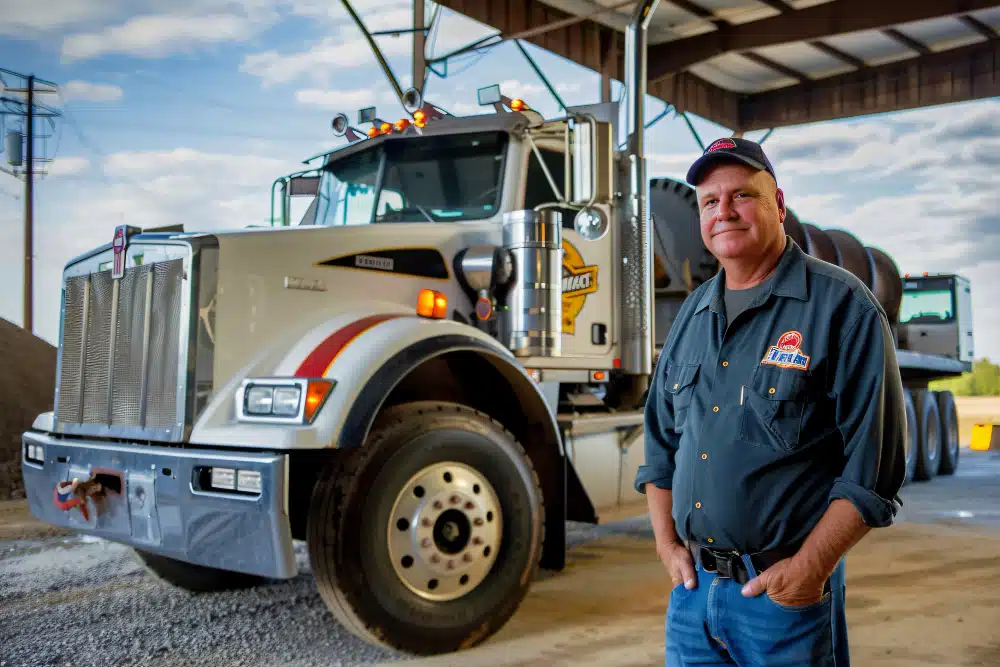
Noise Reduction: Acoustic barriers or insulated walls to minimize noise pollution
Noise pollution can be a significant concern in truck wash bays, particularly in urban areas. The constant operation of high-pressure washers and heavy machinery generates sound levels that may disturb nearby residents and businesses.
Implementing acoustic barriers is an effective solution. These structures absorb sound waves, significantly reducing the noise emitted from washing operations. Strategically placing them around the perimeter of your facility can create a quieter environment without sacrificing performance.
Insulated walls also play a crucial role in minimizing noise. By using materials designed to dampen sound, you ensure that both employees and surrounding communities experience less disruption during daily operations.
Investing in these noise reduction strategies not only enhances worker comfort but also builds goodwill with neighbors. A quieter truck wash bay promotes a more pleasant atmosphere for everyone involved while maintaining operational efficiency.
Technology Integration Control System:
Centralized control panel for managing equipment, pressure settings, and chemicals Automation: Timers, sensors, and automatic shutoff systems to reduce labor and resource usage Fleet Management Integration: Digital tracking systems for wash cycles and service logs Surveillance and Security: CCTV cameras and remote monitoring to secure the area and ensure compliance
A well-designed truck wash bay thrives on efficient technology integration. A centralized control panel allows operators to manage equipment, adjust pressure settings, and regulate chemical usage all from one spot. This streamlined approach enhances operational efficiency.
Automation plays a crucial role in minimizing labor costs and optimizing resource utilization. Timers and sensors intelligently monitor processes, ensuring that wash cycles are consistent while the automatic shutoff systems prevent waste.
Digital tracking systems enhance fleet management by providing detailed insights into wash cycles and service logs. These records help businesses maintain accountability and improve scheduling.
To further bolster security, CCTV cameras provide surveillance of the entire area. Remote monitoring capabilities ensure compliance with safety regulations while deterring potential issues before they escalate. This combination of technology creates a secure environment for both workers and vehicles alike.
Comfort and Convenience for Workers Breakroom and Facilities:
Separate space for workers to rest, with basic facilities (lockers, restroom, kitchen) Lighting: Ample lighting for nighttime operation and dark areas within the wash bay Equipment Storage: Organized storage areas for tools, chemicals, and cleaning accessories
Creating a comfortable environment for workers is essential in any truck wash bay. A dedicated breakroom allows staff to recharge during their shifts, complete with basic amenities like lockers, restrooms, and a kitchen area. Access to these facilities promotes well-being and enhances productivity.
Proper lighting throughout the workspace cannot be overlooked. Ample illumination ensures safety during nighttime operations and brightens dark corners within the wash bay. It not only aids visibility but also creates an inviting atmosphere for employees.
Storage solutions play a vital role as well. Organized areas for tools, chemicals, and cleaning accessories streamline workflows while keeping everything easily accessible. A clutter-free environment minimizes hazards and maximizes efficiency. When workers feel supported in their space, they are more likely to perform at their best.
Cost and Maintenance Considerations Initial Investment: Breakdown of construction costs, equipment, and setup fees.
Ongoing Maintenance: Regular maintenance schedule for washers, reclaim systems, and flooring
Operational Costs: Estimation of water, chemical, and energy usage
When considering the establishment of a truck wash bay, the initial investment is crucial. This includes construction costs, which can vary based on location and design complexity. Equipment purchase also requires significant funding—from high-pressure washers to automated systems.
Ongoing maintenance should not be overlooked. Regular checks for wear and tear on washers and reclamation systems are essential to ensure effective operations. Flooring must also be maintained to prevent slips and extend its lifespan.
Operational costs will play a big role in budgeting as well. Estimating water consumption is vital, especially with regulations focusing on conservation. Chemical expenses add up too; choosing eco-friendly options can sometimes reduce long-term costs while appealing to environmentally-conscious customers.
Energy usage represents another layer of operational expenditure—efficient equipment can make a substantial difference in monthly bills.
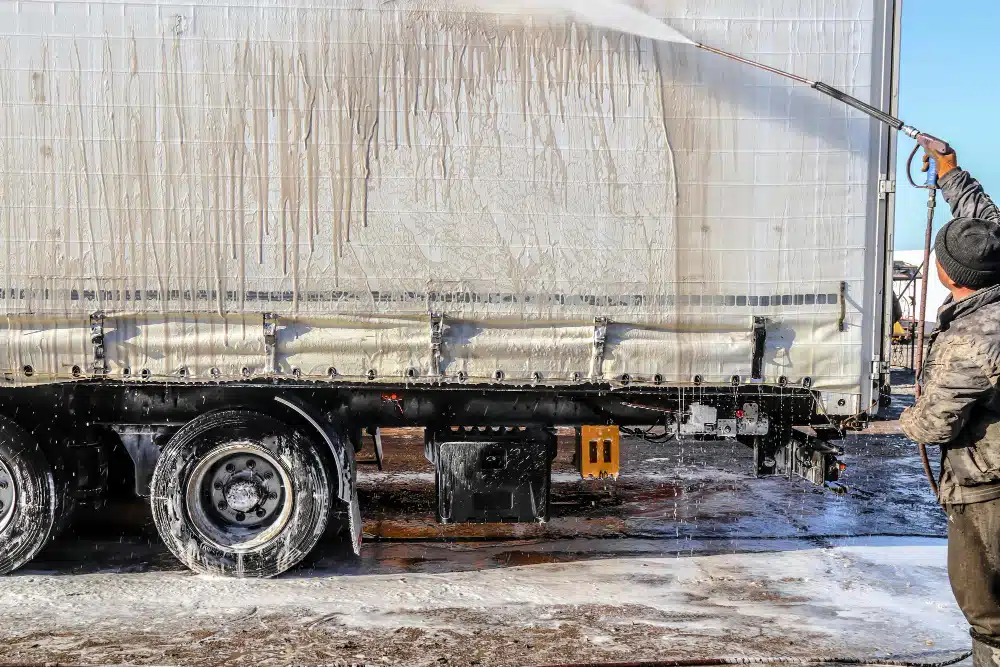
What constitutes a clean truck wash that pleases customers
A clean truck wash is not just about sparkling surfaces; it’s about creating an experience that leaves customers satisfied. The first impression starts with the facility’s exterior and cleanliness. A well-maintained entrance sets the tone for what lies ahead.
Inside, clear signage guides drivers seamlessly through the wash process. This reduces confusion and enhances efficiency. When trucks emerge from a wash bay, they should be free of grime, grease, and road debris—an indication of effective cleaning practices in place.
Customers appreciate attention to detail. Features like spotless rims, shiny mirrors, and a thorough undercarriage rinse signal professionalism. Offering additional services such as waxing or interior vacuuming can elevate customer satisfaction further.
Moreover, quick turnaround times are essential. Customers value their time; thus efficient washing systems minimize wait periods while maintaining high standards in service quality.
Gathering feedback plays a vital role in understanding customer needs better. Listening to concerns or suggestions fosters trust and loyalty among clients who want their vehicles treated right each visit.
Creating this ideal environment not only boosts business but also ensures customers leave happy after each wash cycle!

